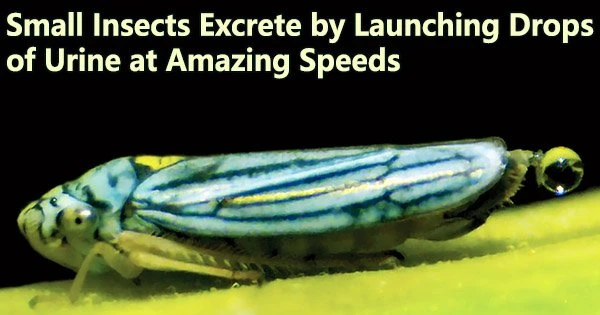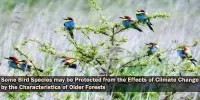When Saad Bhamla saw an insect peeing, it was the first time he had ever seen it. The bug created a virtually circular droplet on its tail, launched it so fast that it appeared to vanish, but it was almost impossible to notice. The small insect regularly went to the bathroom for hours.
What goes in must come out is a commonly held belief, hence research on fluid dynamics in animals has mostly concentrated on feeding rather than excretion. But, Bhamla, an assistant professor in the Georgia University of Technology’s School of Chemical and Biomolecular Engineering, had a suspicion that what he had observed wasn’t insignificant.
“Little is known about the fluid dynamics of excretion, despite its impact on the morphology, energetics, and behavior of animals,” Bhamla said. “We wanted to see if this tiny insect had come up with any clever engineering or physics innovations in order to pee this way.”
Bhamla and Elio Challita, a bioengineering graduate student, investigated how and why glassy-winged sharpshooters tiny pests notorious for spreading disease in crops excrete the way they do.
The researchers investigated the fluidic, energetic, and biomechanical principles of excretion using computational fluid dynamics and biophysical tests, illuminating how an insect no bigger than the tip of a pinky finger pulls off a feat of physics and bioengineering superpropulsion. This study, which appeared in Nature Communications, represents the first account of this phenomena in a biological system.
Small but Mighty: Observing Insect Excretion
High-speed cameras and microscopy were utilized by the researchers to closely monitor what was occurring on the insect’s hind end. They first pinpointed the function of a crucial biophysical instrument called an anal stylus, or “butt flicker,” as Bhamla put it.
Little is known about the fluid dynamics of excretion, despite its impact on the morphology, energetics, and behavior of animals. We wanted to see if this tiny insect had come up with any clever engineering or physics innovations in order to pee this way.
Saad Bhamla
Challita and Bhamla noted that the anal stylus rotates from a neutral position backward to provide space as the insect squeezes out the liquid when the sharpshooter is prepared to urinate. The stylus maintains the same angle while the droplet forms and grows progressively.
The stylus turns backwards by about 15 degrees as the droplet gets close to its ideal diameter, at which point it propels the droplet with amazing speed like the flippers on a pinball machine. The stylus can accelerate more than 40Gs 10 times higher than the fastest sportscars.
“We realized that this insect had effectively evolved a spring and lever like a catapult and that it could use those tools to hurl droplets of pee repeatedly at high accelerations,” Challita said.
The researchers then calculated the anal stylus movement speed and compared it to the droplet speed. They saw something puzzling: the airborne droplets moved more quickly than the anal stylus that flicked them. The droplets launched at rates that were 1.4 times faster than the anal stylus, which was faster than they had anticipated.
The speed ratio indicated the possibility of superpropulsion, a theory that had only been demonstrated in artificial systems and in which an elastic projectile gains energy when its launch time coincides with the projectile time, much like a diver timing their jump off a springboard.
The stylus squeezed the droplets, storing energy due to surface tension immediately before launch, they discovered after more investigation. The water droplets were placed on an audio speaker, and the researchers used vibrations to compress them quickly to test this. They found that the surface tension of water droplets causes them to store energy when they are launched at very small sizes. And if timed just right, droplets can be launched at extremely high speeds.
But the question of why sharpshooters urinate in droplets was still unanswered. A sharpshooter’s diet consists solely of plant xylem sap, a nutrient-poor liquid with only water and a minuscule amount of minerals. They are required to continuously drink and effectively excrete their fluid waste, which is 99% water, because they can consume up to 300 times their body weight in xylem sap each day.
On the other hand, certain insects have the ability to discharge in strong jets while still feeding only on xylem sap.
The team sent sharpshooter samples to a specialized lab. Micro CT scans enabled Bhamla and Challita to study the sharpshooter’s morphology and take measurements from inside the insects. In order to determine how much energy was needed for a sniper to urinate, they used the information to compute the pressure necessary for a sharpshooter to drive the urine through its incredibly narrow anal canal.
According to their research, sharpshooters use superpropulsive droplet ejection as a tactic to save energy during each feeding-excretion cycle. Due of their small size and energy limitations, sharpshooters confront significant fluid dynamic issues, and the most energy-efficient way for them to eliminate waste is by peeing in droplets.
Promising Applications for Insect Superpropulsion
The study has ramifications for numerous fields by fusing biology, physics, and engineering. Applications for ecology and population dynamics can be drawn from a better understanding of the function that excrement plays in animal behavior, size, and evolution.
For example, sharpshooters are a major agriculture pest in California and Florida as they spread diseases in vineyards and citrus crops, causing millions of dollars of damage. Sharpshooter excrement may be used as a vector surveillance technique since the problem is predicted to worsen as a result of climate change. The team’s analysis also highlights how crucial it is to research feces processes because they can provide a wealth of information about an organism’s behavior.
Sharpshooters’ use of superpropulsion can be studied to learn more about how to develop systems that defy adhesion and viscosity while using less energy. One example is low-power water-ejection wearable electronics, such as a smart watch that uses speaker vibrations to repel water from the device.
“The subject of this study may seem whimsical and esoteric, but it’s from investigations like this that we gain insight into physical processes at size scales outside of our normal human experience,” said Miriam Ashley-Ross, a program director in the Directorate for Biological Sciences at the U.S. National Science Foundation, which partially funded the work.
“What the sharpshooters are dealing with would be like us trying to fling away a beachball-sized globe of maple syrup that was stuck to our hand. The efficient method these tiny insects have evolved to solve the problem may lead to bio-inspired solutions for removing solvents in micro-manufacturing applications like electronics or shedding water rapidly from structurally complex surfaces.”
For the most part because it is rarely considered, the simple fact that insects urinate is intriguing in and of itself. Yet, the researchers’ work uncovers additional dimensions for appreciating little behaviors beyond what is immediately apparent by using the lens of physics to examine a commonplace miniature biological function.
“This work reinforces the idea of curiosity-driven science being valuable,” Challita said. “And the fact that we discovered something that is so interesting superpropulsion of droplets in a biological system and heroic feats of physics that have applications in other fields makes it even more fascinating.”
















